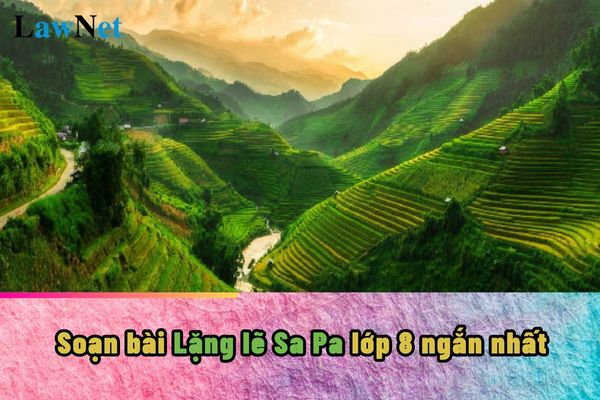What are guidelines on preparing the lesson "Lặng lẽ Sa Pa" for grade 8 students in Vietnam? Are grade 8 students in Vietnam allowed to use equipment for study?
What are guidelines on preparing the lesson "Lặng lẽ Sa Pa" for grade 8 students in Vietnam?
"Lặng lẽ Sa Pa" is part of the content that grade 8 students will study.
Therefore, grade 8 students can refer to the following guidelines on preparing the lesson "Lặng lẽ Sa Pa":
|
Guidelines on preparing the lesson "Lặng lẽ Sa Pa" for grade 8 students * Main Content of the Lesson |
*Note: The information is for reference only./.

What are guidelines on preparing the lesson "Lặng lẽ Sa Pa" for grade 8 students in Vietnam? Are grade 8 students in Vietnam allowed to use equipment for study? (Image from the Internet)
What are the contents of Vietnamese language knowledge in grade 8 Literature in Vietnam?
Based on Clause 2, Section 5 of the General Education Program for the Literature subject issued with Circular 32/2018/TT-BGDDT, the content of the Literature subject for grade 8 students includes:
(1) CONTENTS OF VIETNAMESE LANGUAGE KNOWLEDGE
- Meaning of some relatively popular idioms and proverbs
- Shades of meaning of words and word choice
- Onomatopoeic words and ideophones: characteristics and effects
- Meaning of some common Sino-Vietnamese elements (e.g., vô, hữu) and the meaning of words containing those elements (e.g., vô tư, vô hình, hữu quan, hữu hạn)
- Particles, exclamations: characteristics and functions
- Isolated components in a sentence: characteristics and functions
- Declarative, interrogative, imperative, and exclamatory sentences; affirmative and negative sentences: characteristics and functions
- Rhetorical devices of inversion, rhetorical question: characteristics and effects
- Explicit meaning and implicit meaning of sentences
- Types of paragraphs: deductive, inductive, parallel, coordinated: characteristics and functions
- Types of text and genres
+ Narrative text: an essay narrating a trip or a social activity
+ Expressive text: six-syllable and seven-syllable poetry; a paragraph expressing feelings about a six or seven-syllable poem
+ Argumentative text: thesis, argument, reasoning and evidence; a discussion paper on a life issue; an analysis of a literary work
+ Informational text: objective information, subjective opinion and purpose of the text; explanatory text explaining a natural phenomenon; an introduction to a book; a petition text
- Common and regional dialect words: function and value
- Social jargon: function and value
- Non-verbal communication means: images, data, diagrams,...
(2) CONTENTS OF LITERARY KNOWLEDGE
- Imagination in literary works
- Titles and ways to title a text
- Theme and subject, ways to identify the subject; structure
- Plot, setting, character, language in jokes, historical stories
- Single-line plot and multi-line plot
- Main artistic methods of satirical poetry
- Some elements of the laws of poetry in Tang poetry: layout, rhyme, rhythm, cadence, opposition
- Some formal elements of a poem: words, imagery, layout, emotional flow
- Conflict, action, character, dialogue, satirical methods in literary scripts (comedy)
- Some formal elements of free verse (six, seven syllables): number of lines, words, rhyme, rhythm
- Reader and individual reception of a literary text
- Content reflection and perspective on life and people by the author.
Are grade 8 students in Vietnam allowed to use equipment for study?
According to Article 35 of the Charter of lower secondary schools, upper secondary schools, and schools with multiple grade levels issued by the Ministry of Education and Training with Circular 32/2020/TT-BGDDT, grade 8 students have several rights as follows:
(1) Be equal in enjoying comprehensive education, have conditions ensured regarding time, physical facilities, hygiene, and safety for studying in class and self-study at home, be provided with information about their study and training, and use equipment and means serving learning, cultural and sports activities of the school as prescribed.
(2) Be respected and protected, treated with equality and democracy, have the right to complain to the school and educational management levels about decisions affecting themselves; have the right to transfer schools for legitimate reasons following current regulations; have the right to advance or skip a grade, study at an age higher than the prescribed age according to Article 33 of the Charter of lower secondary schools, upper secondary schools, and Schools with Multiple Grade Levels issued by the Ministry of Education and Training with Circular 32/2020/TT-BGDDT.
(3) Participate in activities to develop talents in subjects, sports, arts organized by the school if eligible.
(4) Receive scholarships or other allowances according to regulations for students enjoying social policies, students with life difficulties, and students with special abilities.
(5) Transfer schools if eligible according to regulations; school transfer procedures are implemented following the regulations of the Minister of Education and Training.
(6) Enjoy other rights under the law.
one of the rights of Grade 8 students is to advance or skip a grade, study at an age higher than the prescribed age according to Article 33 of the Charter of lower secondary schools, upper secondary schools, and Schools with Multiple Grade Levels issued by the Ministry of Education and Training with Circular 32/2020/TT-BGDDT.
Thus, grade 8 students fully have the right to use equipment for learning.

